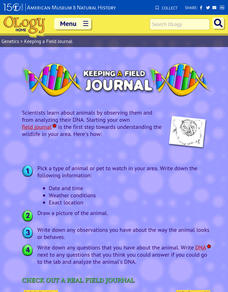Curated OER
A Bearrific Home Adventure
Students and their families participate in an at home journal activity. In this journal writing lesson, students read the book If You Take a Mouse to School. Students take home a suitcase with a bear and writing elements. Students return...
Curated OER
Meadow Madness
Students explore the evolution from a pond habitat to a meadow. In this habitat lesson plan, students become familiar with a beaver meadow habitat. Students are aasigned an animal to research and find why the animal best survives in...
Curated OER
Using technology to engage students in science through inquiry research
Students study animals and their behaviors. For this animal behavior lesson students divide into groups and collect data and research animal behaviors.
Curated OER
Diversity and Adaptations of Organisms
Eighth graders discover how animals adapt to their surroundings. They identify physical traits and behaviors that are important to survival. They examine the results of an organism's failure to adapt.
Curated OER
Jane Goodall
Students identify Jane Goodall as a scientist who studies the behavior of chimpanzees. They listen to a biography of Jane Goodall and review the location of Africa. Then students participate in an animal observation activity.
Curated OER
It Takes All Kinds!
Students view video clips and observe similarities and differences between animals. They sort animals into groups for a zoo. They make a graph of their observations and review scientific classifications.
Curated OER
Seashore Limitations
Students demonstrate the movements and behaviors of creatures from different parts of the ocean.
Curated OER
Hide & Seek Butterflies
Students examine a variety of butterflies and discuss how they believe they get their color variations. In groups, they brainstorm the advantages and disadvantages of their color schemes. To end the lesson, they watch butterflies in...
Curated OER
School Forest Lesson- Looking at Literature
Students compare what they learned though literature to the school forest. In this environment lesson, students visit the forest surrounding their school to listen to literature and identify objects in nature. Students create a display...
Curated OER
"Home Sweet Home?"
Students research an endangered animal's habitat, investigate the survival problems. They research the animal's zoo life. They research some programs of reintroduction and chart the pros and cons of each.
Curated OER
Surveying an Environment / Ecosystem
Young scholars visit a local ecosystem to survey the plants and animals present and identify interactions between organisms. They identify interactions that occur between living organisms and their ecosystem and present their ecosystem...
Curated OER
Deer Tracks
Students use satellite images to track to movement patterns of deer and examine deer behavior. They write stories about a day in the life of a field scientist.
Curated OER
Hogs on a Diet
Students discuss the meaning of "hogging" something, and speculate on the origin of this phrase. They attempt to guess the contents of a shoe box (without looking inside). Students view feed grains and discuss animals that eat these...
Curated OER
Making Tracks
Fifth graders examine the fossil footprints of two and four legged dinosaurs. Using this information, they try to determine how the dinosaurs lived their lives. They use their own walking pattern to compare it to the dinosaurs and...
Curated OER
Endangered Species
Pupils conduct Internet research on endangered species. They select an endangered species, identify its physical and behavioral characteristics, and create a Powerpoint presentation.
Curated OER
Evolution
Pupils illustrate the results of natural selection by identifying the specific adaptation of an organism that allows the species to survive in that environment. They illustrate the results of natural selection by recognizing examples of...
Curated OER
Earthworm Movement and Landscape Structure
Students describe differences in animal usage of habitats depending upon successional status of site. They also design other experiments to test movement patterns of animals through habitats of differing structure.
Curated OER
Can You Hear It?
Students work together to discover the concept of echolocation. They examine dolphins and their behaviors. They discuss how humans could use this information to help them in their everyday lives as well.
Curated OER
"For the Birds" [part I]
Young scholars identify birds that appear in Chinese and Japanese art, learning about
their physical characteristics, classifying them according to scientific principles, and exploring their habitats and migration patterns. This is part...
Curated OER
OBSERVING THE ROLES OF MALES AND FEMALES IN THE NURTURING OF THE YOUNG THROUGHOUT THE ANIMAL KINGDOM
Students watch animal videos to identify and compare the male/female roles of different species of animals. They draw conclusions and compare those roles to those of humans. They discuss how the human male/female roles have changed...
Curated OER
Little Me in a Big World: Ants
Students use the life cycle of an ant to learn about their own self-esteem. For this self-esteem lesson, students read books about ants and discuss obstacles from the stories as well as the ant behavior.
American Museum of Natural History
Keeping a Field Journal
Young scientists begin a field journal by following four steps. A real-world example of an entry showcases the different parts, including location, date, drawings, and more.
Teach Engineering
Red Cabbage Chemistry
Using the natural pH indicator of red cabbage juice, groups determine the pH of different everyday liquids. As they work, pupils gain an understanding of pH that may help deal with contaminants in the water supply.
Curated OER
Nature Tribute
Students explore parts of nature. In this environmental lesson, students discuss how their actions can affect the environment and design a plan to clean up a specified area. Students practice good hygiene during the cleanup project.






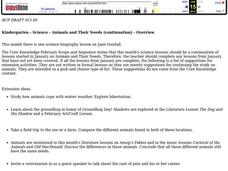
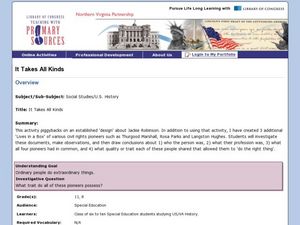






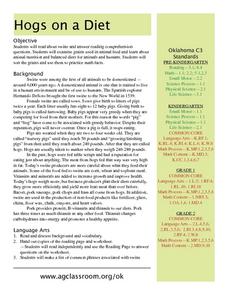

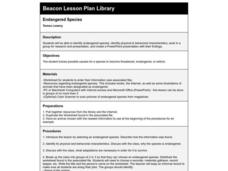


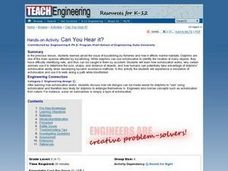
!["For the Birds" [part I] Lesson Plan "For the Birds" [part I] Lesson Plan](http://content.lessonplanet.com/resources/thumbnails/122462/large/cgrmlwnvbnzlcnqymdeymtaxny0ynji5lwd4n2h5by5qcgc.jpg?1414222903)


